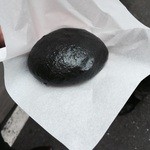
まる一 浜田商店
Maruichihamadashouten
3.11
Tsukiji
「Other」
--
--
Opening hours: 5:00-12:00
Rest time: Sundays, national holidays, and market closure days Business hours and holidays are subject to change, so please check with the store before visiting.
東京都中央区築地4-13-3
Photos
(20)

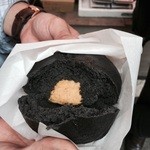
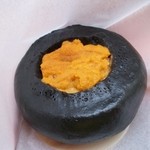
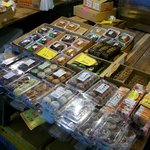
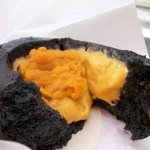

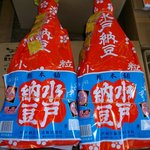
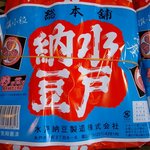
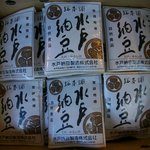

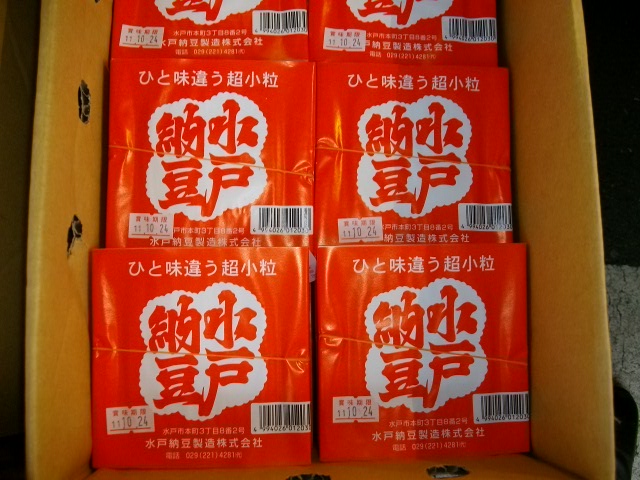
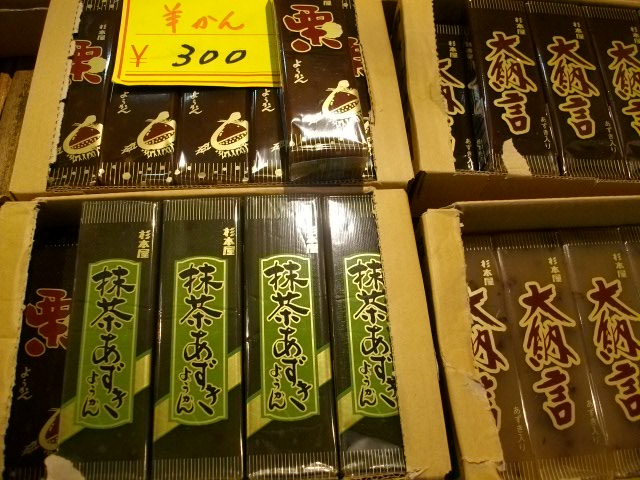
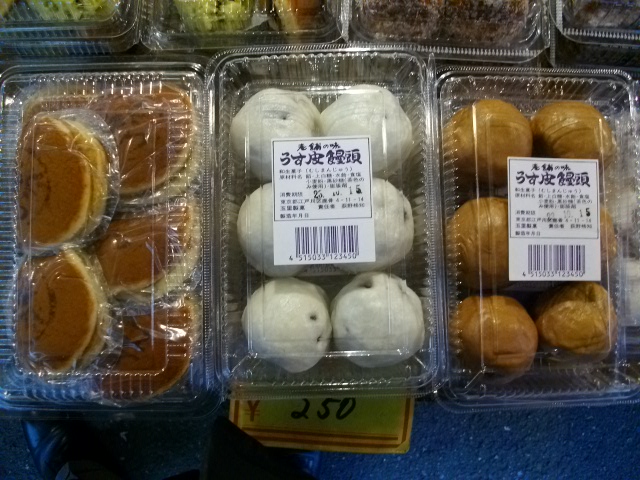
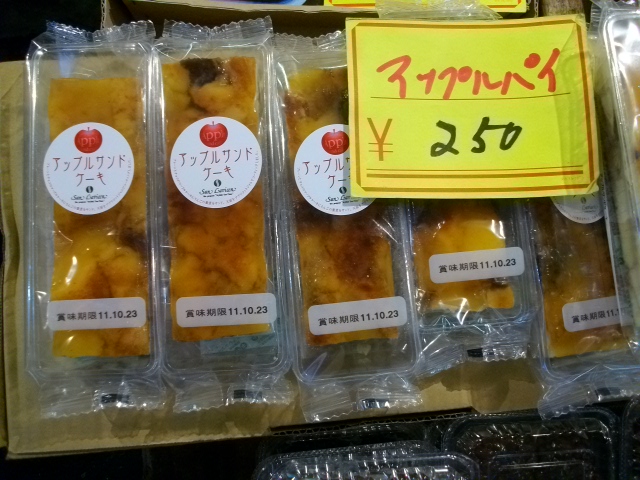
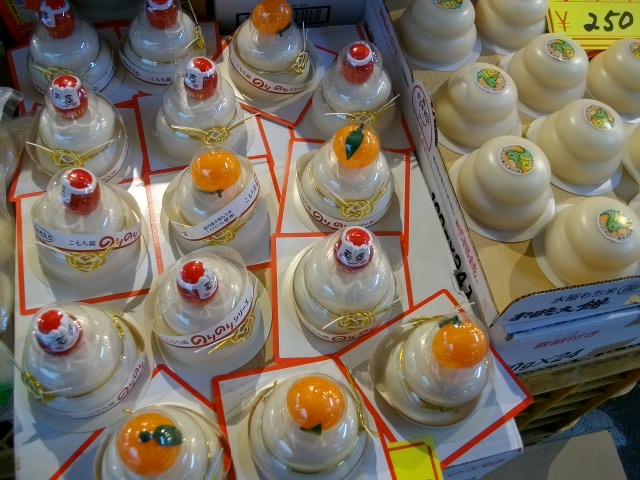

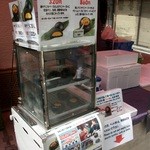

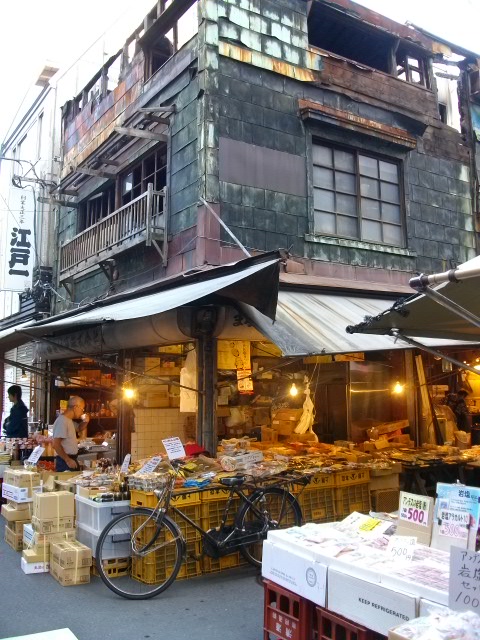
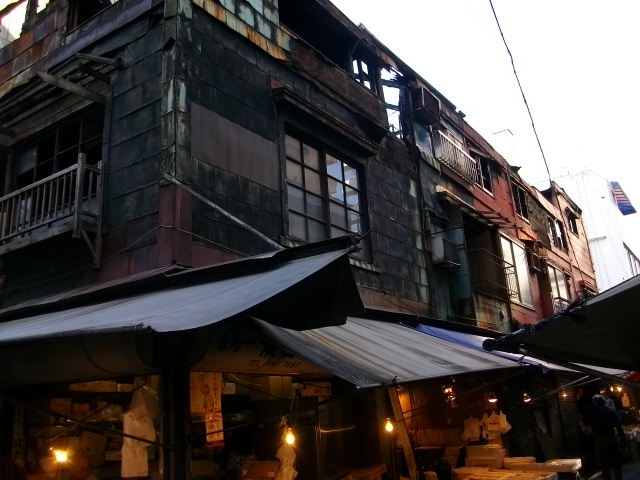
Details
Number of Seats
(Specializing in over-the-counter sales)
Smoking and Non-Smoking
No smoking at the table
Comments
(20)
林檎おやじ
1.00
"Uni Man"
ns26
2.00
Not delicious
飲みニスト0430
3.00
On my day off, I went to Tsukiji... Today is my day off, so I leisurely strolled around Tsukiji from the morning... I had a delicious seafood bowl at Iso Sushi for breakfast, and then I wandered around the Tsukiji outer market to see if there was anything else tasty to eat... It's really crowded in Tsukiji today... It's hard to walk around the streets... While strolling around, I found a product called "Kanmon Uni Man" at Maruichi Hamada Shoten!! -Kanmon Uni Man, Gokoku 860 yen -Kanmon Unimon 320 yen I wanted to try the Gokoku version, but it was a bit expensive, so I ordered the regular Kanmon Uni Man first!! A black dough with a bright yellow uni paste. The flavor of the uni was strong and delicious. I wonder what the Gokoku version tastes like? Looking forward to trying it next time...
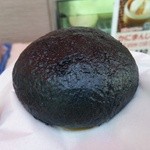
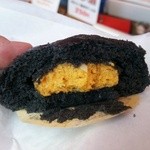
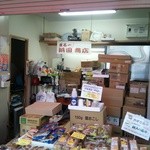
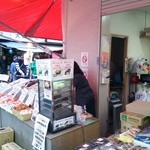
食べ歩き人・・・
3.10
Tonight's third stop on my Tsukiji exploration and food tour is Maruichi Hamada Shoten. The popular item here is the Sekimon Uni Man, which has recently been gaining popularity. Originally from Fukuoka, the izakaya Sekimon created this product. It has now made its way to Tsukiji, Japan's kitchen, through online sales. There are two flavors available: Sekimon Uni Man for 320 yen and Sekimon Uni Man Kyoku for 860 yen. The Sekimon Uni Man is made with a base of blended sea urchin and fish meat. The Kyoku version includes both blended sea urchin and fresh sea urchin. What a luxurious treat! I chose the Sekimon Uni Man. The black dough made me think it was squid ink, but it actually contains bamboo charcoal. When you split it open, the scent of sea urchin is amazing! This is delicious! A must-try for sea urchin lovers! Perfect for a food tour, so be sure to try it out! Thank you for the meal!
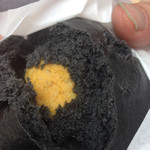
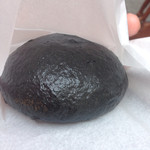
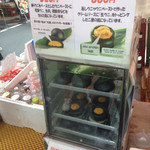
1食3合
3.00
On a regular day before noon, I took the Hibiya Line to Tsukiji Station!!! I took a paid day off today, and I'm going to eat my way through Tsukiji!!! The main dish will be sushi, but before that, let's start with some light exploration and eat a lot!!! First stop, "Hamada Shoten" Their name and appearance caught my attention, and I couldn't help but stop!!! Their specialty is the "Kanmon Uni Manju" for 320 yen each, a popular item that can also be ordered online!! It seems to have been featured on TV as well!! (I had no idea! I need to do more research) The outer skin is mixed with bamboo charcoal, making it look completely black, which is quite impactful!! When you break open the hot Uni Manju, you'll find a generous amount of uni paste inside!! Indeed, it looks just like uni!! It's a unique taste that could become a talking point!!! Now, off to the second place!!!
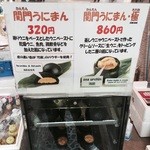
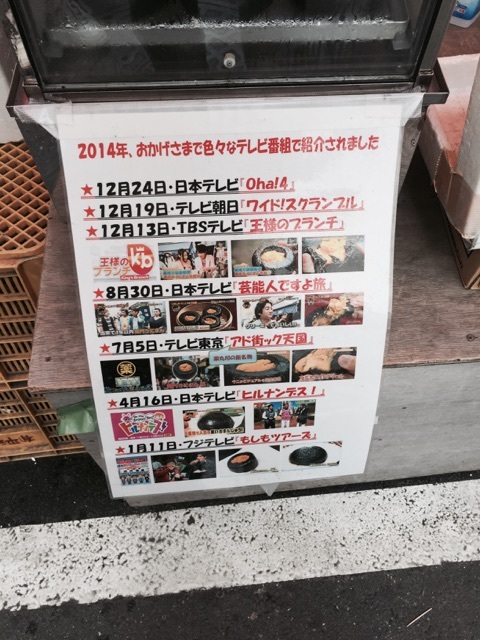


熊プー
3.20
I went to the third store to try the new specialty dish in Tsukiji that has been featured in the media. The shop is selling two types of their specialty, Kanmon Uni Manju for 320 yen and Kanmon Uni Manju Extreme for 860 yen. The Kanmon Uni Manju uses Uni paste filling, while the Extreme version uses fresh Uni. The Extreme version is made with bamboo charcoal dough filled with fresh Uni and creamy Uni paste. It was delicious without the typical strong smell or taste of Uni. Although it's a bit pricey at 860 yen, it's definitely a must-try dish.
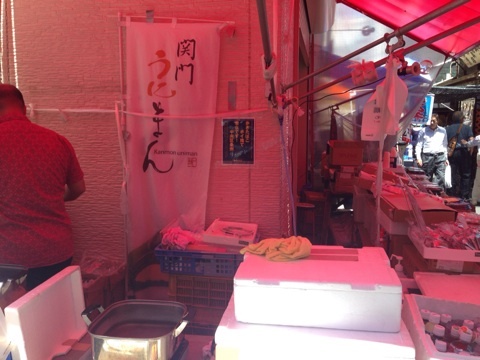
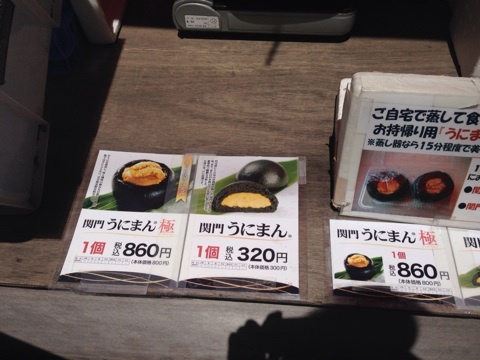
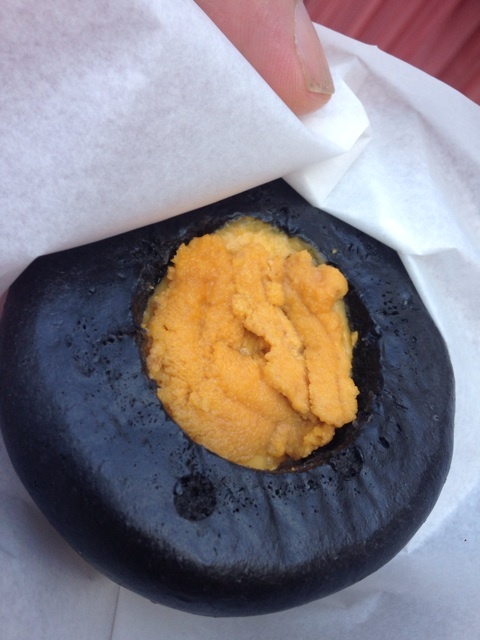
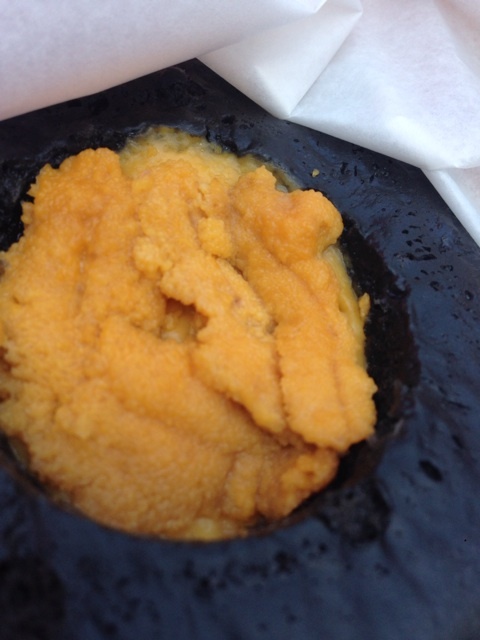
nemocco
3.00
The other day, I visited this place when I was strolling around Tsukiji. They have a hot showcase with uni cream-filled manju wrapped in black skin. Inside, there are two types of manju: one with a filling made of uni paste, fish meat, and dried uni called Kanmon Uni Man, and the other one called Kanmon Uni Man Gok with a cream sauce made of uni paste and topped with fresh uni. When asked which one to choose, my husband and friend opted for the more luxurious Kanmon Uni Man Gok. I also tried a bit from my husband. The Kanmon Uni Man Gok costs 860 yen and has a black bamboo charcoal dough that looks very striking. The top is open to show the uni on it, giving it a luxurious appearance. The fresh uni has no fishy smell, and the cream sauce made of steamed uni and uni paste is rich and smooth. Even if you're not a big fan of uni, it tastes delicious. However, considering the price... it does feel a bit expensive, so maybe it's worth trying once. If you enjoy uni or unique gourmet experiences, I recommend trying either the uni manju or the Kanmon Uni Man Gok as a snack during your Tsukiji exploration.
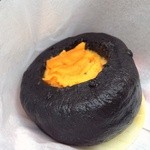


メッセンジャー
2.20
I think it's unusual, but I wonder why they made this? I went to buy it after seeing it featured on TV and in magazines. It is displayed in containers like the ones for convenience store meat buns. There are also some available as souvenirs. I wonder if they are not steamed? There are only two types available, a 300 yen sea urchin bun and an 800 yen "ultimate" bun. Of course, I ordered the "ultimate" one. It comes in a paper bag like at a convenience store, so you can eat it on the go. Now, as for the taste, the skin is soggy and not tasty. The sea urchin seems to be more like a paste than actual uni. Honestly, it's hard to eat and not delicious. Maybe it's been sitting out for too long? Well, I won't be trying it again.
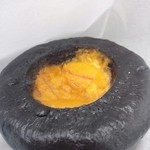
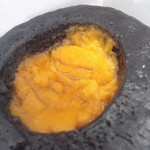
七五郎
3.80
About 2 years ago, a friend from Kitakyushu sent me some "uni manju" which I reviewed on Tabelog after ordering it. Originally, it was said to be a new specialty in Moji Port, but now it has become a "new specialty in Tsukiji" (laughs). This place is where I occasionally buy natto, and they have been in the business of selling food products primarily outside the market for a long time. Somehow, they have a steamer for steamed buns in a corner of the store where they sell "uni manju". The "uni manju" being sold comes in two types, priced at 320 yen and 860 yen. The 320 yen one was the one my friend sent me before, so this time I bought the 860 yen one. The main difference is in the filling, where the 320 yen one is based on "paste uni" and wrapped in black skin. The 860 yen one is based on "fresh uni" and has a lid-like shape on top with uni perched on it. When I tried to take a bite, it was very hot! When I split it in half, I found uni perched on top with a creamy paste underneath. The taste is similar to the sauce used for "uni cream pasta". Surprisingly, it was delicious (laughs). It might be nice to tear the black skin and eat it while dipping it in this creamy sauce. Therefore, it may not be suitable for the trendy "food walking" in Tsukiji? It might be better to have it served on a plate to eat it with peace of mind. They also have takeout options (unsteamed), so if it's not too much trouble, it might be safer to buy and steam it at home. The price of 860 yen may seem a bit high, but it seems to be sold at the manufacturer's price, so let's accept it. It's not like the rip-off "seafood bowl". But still, it's strange that it was developed as a "Moji Port specialty" but has now become a "Tsukiji specialty" - well, as long as it sells, it doesn't matter, right (laughs)? ---------------------------- October 2011 review The period when natto disappeared from the market due to the March 11th earthquake was very tough for me, a natto lover. Of course, I could have endured it, and it might be thought that "not being able to eat natto is just a minor inconvenience in that situation...", but I love what I love, so it can't be helped. The natto I have been hooked on for the past few years is this "Mito Natto". This is a product of Mito Natto Manufacturing Co., Ltd. located in Mito City, Ibaraki Prefecture. According to what I heard, "Mito Natto" is a brand name, not a general term for natto from Mito. In other words, the natto that can bear the name "Mito" is only this one. It was founded in the 4th year of Showa, so it has been about 80 years. The oldest founding in the prefecture is said to be "Tengu Natto" with 100 years, so this one may be the second oldest. The opportunity for me to eat this product was when I received it as a souvenir from Mito. Although the company's products are sold at souvenir shops and service areas in Ibaraki Prefecture, they are surprisingly not sold in Tokyo. However, I was lucky because "Hamada Shoten" in Tsukiji, near my workplace, handled it. According to the website of Mito Natto Manufacturing Co., Ltd., the only places where it is sold in Tokyo are the shops at Haneda Airport and "Hamada Shoten" in Tsukiji. The natto wrapped in straw, which evokes nostalgia, has a unique aroma of straw, and the grains are firm and have a deep flavor. The one in the "pine wood" container also has a scent that stimulates the appetite. The price is high as a result. Now, when you look at the natto section in supermarkets, etc., the mainstream is packs of 3-4 for around 100 yen. In terms of per pack, it is around 25-30 yen. Compared to those, the "straw-wrapped" one here, which comes in a pack of 5, is 735 yen (147 yen per piece / 70g), which is much higher. The one in the "pine wood" container is even more expensive at 210 yen (90g). However, at Hamada Shoten, the pack of 5 "straw-wrapped" natto is 600 yen. The one in the "pine wood" container is 150 yen, which is sold at a much cheaper price. This is truly a Tsukiji price! (Well, sushi and fresh foods are not cheap either). The "straw-wrapped" one here is 735 yen for 5 pieces, which is a bit expensive. The one in the "pine wood" container is 210 yen, which is 90g. However, at Hamada Shoten, the "straw-wrapped" one is 600 yen for 5 pieces. The one in the "pine wood" container is 150 yen, which is much cheaper. This is truly a Tsukiji price! (Well, sushi and fresh foods are not cheap either).

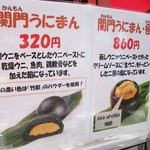
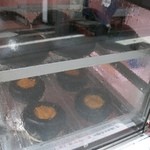

はらへり呑んべぇ
2.90
"Maruichi Hamada Shoten" ☆ A food retail store located at the corner of the "Higashi-dori" and "Tsukiji Yokocho" in the Tsukiji Outer Market. Their "Kanmon Uni Manju" has been a hot topic on their store TV and magazines, and is a popular gourmet item for delivery. Since December 7, 2013, a permanent sales location for "Kanmon Uni Manju" has been established here in the Tsukiji Outer Market! There are two types available, with the cheaper option being created at the "Kaimon" izakaya in Moji Port. The "Kanmon Uni Manju" (320 yen) has a black skin that opens up. The skin uses bamboo charcoal powder. The black skin reveals a filling that is a paste made from uni, dried uni, fish meat, and chicken cartilage. It's a product with a uni flavor! It's just delicious. The more expensive "Kanmon Uni Manju - Kyoku" is priced at 860 yen and has a two-layer filling made from steamed uni, uni paste cream sauce, and topped with fresh uni. If you want to savor the uni, that's the one to go for."
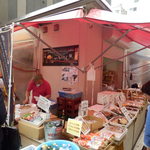
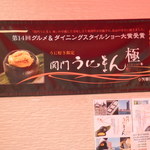
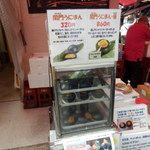
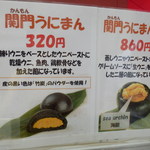
ponpocorin
3.50
"Hamada Shoten" is a store that was affected by a fire about three years ago. It used to be located next to the current "Marutaka" store, alongside a bean shop called "Kisen" that had been in business for 50-60 years. When the building was demolished due to the fire, "Kisen" closed down, but "Hamada Shoten" temporarily moved to a different location and then returned once a new building was constructed. Originally a supplier of food items like natto and tofu, they now also sell popular Japanese sweets known for being delicious yet affordable. Recently, they started selling "Kanmon Uni Man" at the corner of their store, which is a product from a company in Kitakyushu specializing in food and beverages. The product gained popularity through online sales, prompting the company to try selling it at the Tsukiji market's outdoor area. There are two types of "Kanmon Uni Man" available - a basic version with a mixture of uni paste and fish meat priced at 320 yen, and a high-quality version made with fresh uni and a creamy finish priced at 860 yen. The latter resembles a rich uni pasta dish more than a traditional steamed bun, while the former also offers a good balance of uni flavor and chewy texture from chicken cartilage. Both versions feature a unique black dough made with bamboo charcoal powder, adding to the visual appeal. The product's success in sales exceeded expectations, with some days selling over 300 units. Considering the quality and taste, the price is reasonable compared to ordering uni dishes at a sushi restaurant. It's worth trying as a conversation starter or a unique snack. The high-quality "Kanmon Uni Man" pairs well with white wine, making it a versatile option for different occasions. The fact that the price at the outdoor market remains similar to online prices, without inflated tourist rates, is commendable.
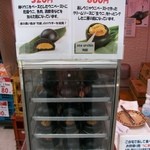
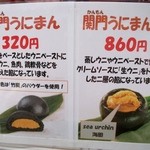
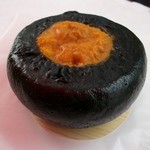
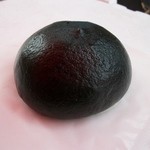
フィンクス
3.00
Walking through the narrow alleyways of Tsukiji's outer market! The Uni Man introduced earlier is here at Maruichi Hamada Shoten! And at their storefront, I found Yasuda Yogurt's drinkable yogurt for only 100 yen! What a deal! The top-notch yogurt from Niigata! Yasuda Yogurt at Tsukiji's outer market! And you can enjoy it for just 100 yen! Did you know? I didn't! The top-notch yogurt is not from Bulgaria, it's from Niigata! It says so right at the storefront! So many things in this world that we don't know about! That's Yasuda's drinkable yogurt, the best of the best! It has a mellow yet refreshing taste! Perfect for refreshing your body after all that food tasting!

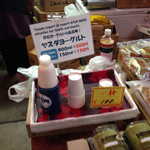
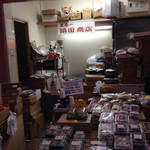
LIBRA
2.90
I wanted to try these two types of steamed buns that I saw on TV! Let's compare them now!
- Kanmon Sea Urchin Steamed Bun "Kyoku" (840 yen): Wow, the sea urchin is on top! This is a strategy to attract sea urchin lovers, right? It's completely black.
- Kanmon Sea Urchin Steamed Bun (300 yen): It's not the "Kyoku" version. The black color comes from bamboo charcoal. It has a yellow paste-like filling. The texture is like cartilage. Where's the sea urchin though? But considering it's a 300 yen steamed bun, it might be reasonable.
The "Kyoku" version is special because of the steamed sea urchin on top! Other than that, the filling is similar to the regular sea urchin steamed bun but softer. The price is high though! The bamboo charcoal skin wasn't particularly delicious, but apparently bamboo charcoal is good for the body... Let's eat it with the mindset of "good medicine tastes bitter." It's unique, so those who enjoy trying new things will definitely want to compare them. I think the originality is nice. It's worth trying once!
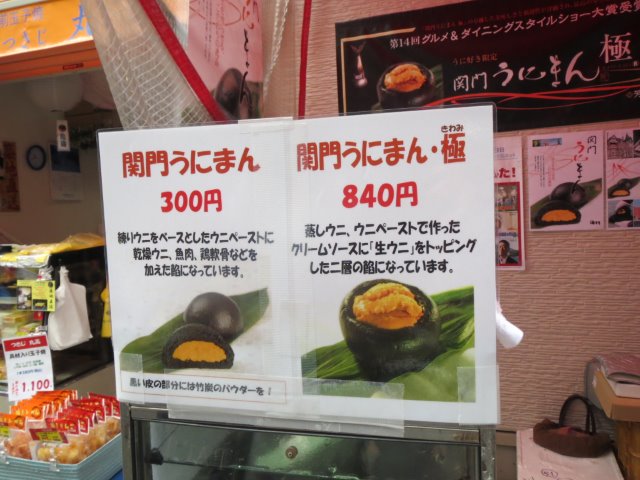
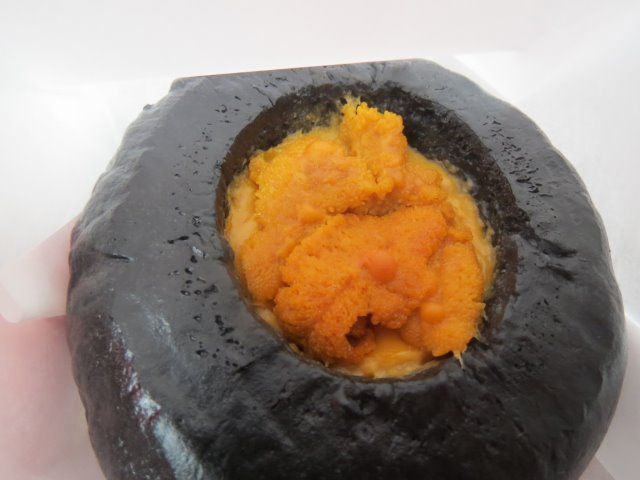
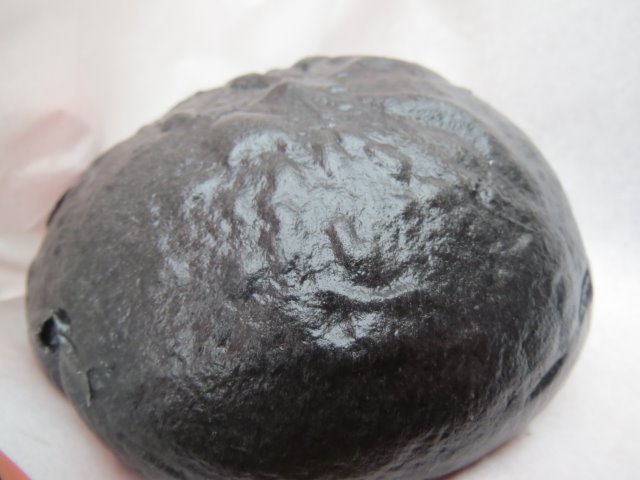
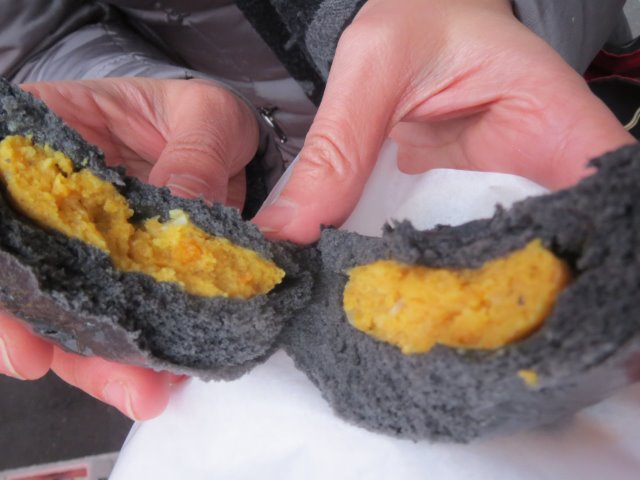
ほぼ週4
3.20
Tsukiji Marutaka is a long-established shop that has been selling various types of tamagoyaki since its founding in 1938. They are known for their voluminous and delicious tamagoyaki, similar to the ones sold at Daitei Higashi Main Store and Sushi Tamaya Aoki in Tsukiji. While wandering around the streets outside Tsukiji, I came across Marutaka, a shop that has been specializing in tamagoyaki since 1938. Interestingly, on the right side of their tamagoyaki sales counter, they also sell something called "Kanmon Uni Man" for 300 yen and "Kanmon Uni Man - Kiwami" for 840 yen. I decided to try the "Kiwami" version, which is a steamed bun filled with uni paste and topped with uni. Despite the slightly high price, the uni and uni paste were delicious, with a perfect balance of sweetness and umami. The dough itself was slightly sweet and tasty. It is worth mentioning that these buns are made by Haga Shigemoto Shoten, a shop specializing in uni buns. Overall, it was a unique and enjoyable experience, even though the price was a bit steep.
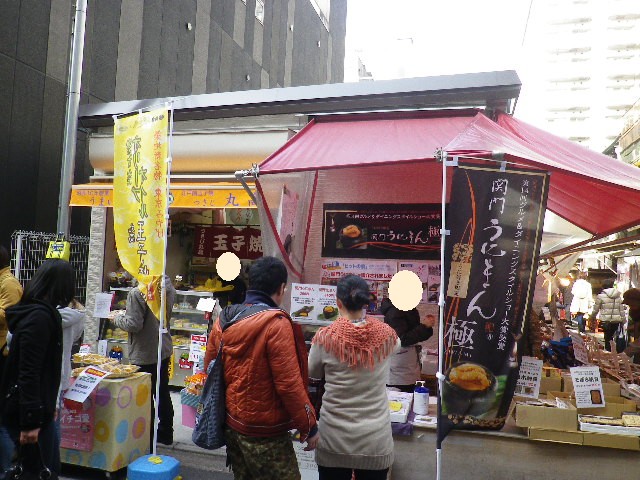
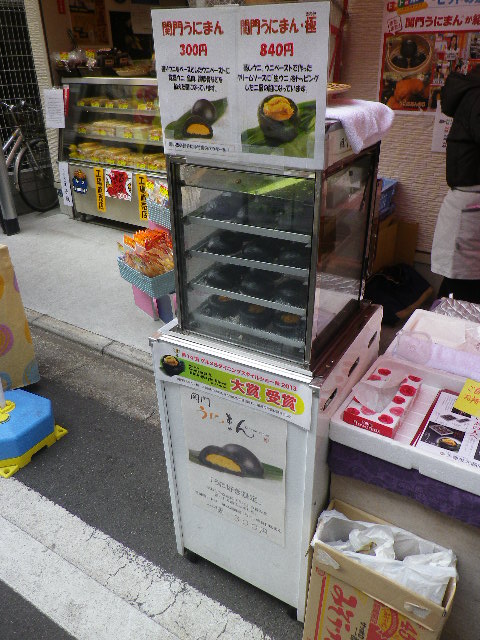
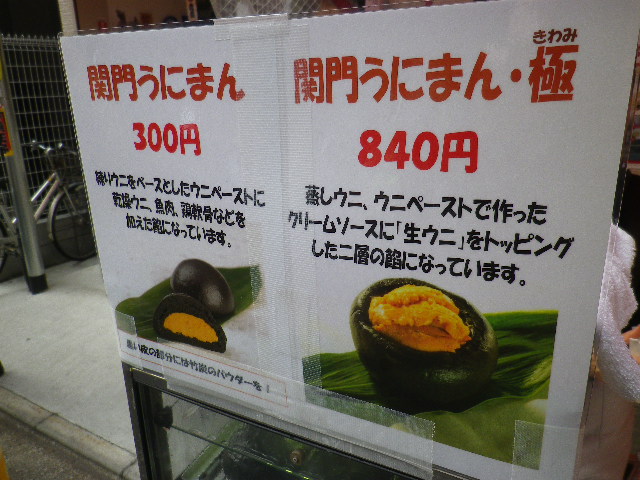

Kaolu
3.10
Kanmon Uni Man / Maruichi Hamada Shoten (Tsukiji Market) I didn't realize this was not actually sea urchin (uni)! According to Ameba News, starting tomorrow, December 7, 2013, there will be a permanent sale at the Tsukiji Outer Market in Tokyo, but it was already being sold today. I wasn't aware of this product beforehand, so I was surprised to find Uni Man, which is rare and cheap! I bought it and tried it on the spot. The black, slightly dry skin part is said to be made with bamboo charcoal... The creamy filling mixed with crunchy grains adds a nice touch and is delicious. Is this actually made from sea urchin shells? No, the pieces are too tasty for that... I thought it was wrapped in sea urchin until I read this article. It really tastes just like sea urchin. The filling is made from processed sea urchin, fish meat, and yam, so it seems like it's not fake. If you eat this without knowing, you would think it's just a regular sea urchin bun. Kaolu's Diary! See all articles here → http://kaolumixi.seesaa.net/category/4636548-1.html

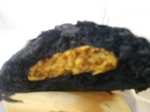
chaco80
3.50
The counter and table seating inside the elegant Toshiiki restaurant, which is connected to Aki-Chiku, leads to Maruichi Hamada Shoten along the way. This shop has been operating here since February, although it is a temporary location. This is because one of the shops was affected by a fire outside Tsukiji last summer, and reconstruction work has begun there. They mainly sell traditional Japanese sweets, Mito natto, tofu, and yogurt. While sweets like "Sanokiya" or "Moshuke Dango" are popular for snacking in Tsukiji, this shop doesn't specifically cater to that. However, they kindly offered to sell some of their sweets individually for tasting, so I tried the "Chatsu" (50 yen each). Surprisingly, it was delicious despite its appearance. It might be nice to enjoy it with hot tea on a cold day like today. So, I ended up buying a pack. In the end, I ended up eating half of the pack (3 pieces) while strolling around. Maruichi Hamada Shoten will resume operations at its original location in August. Thank you for the meal.
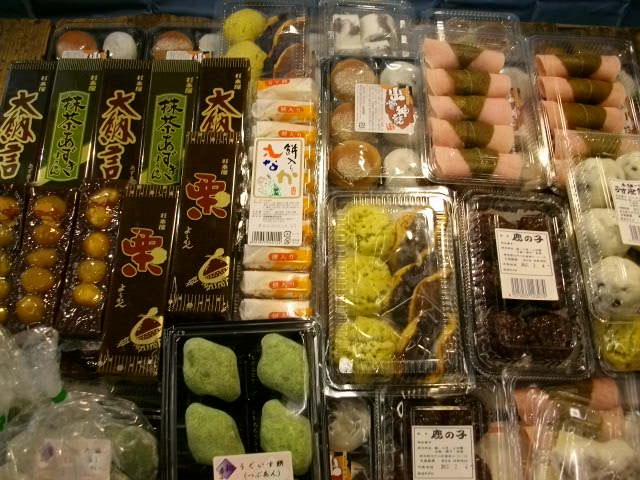
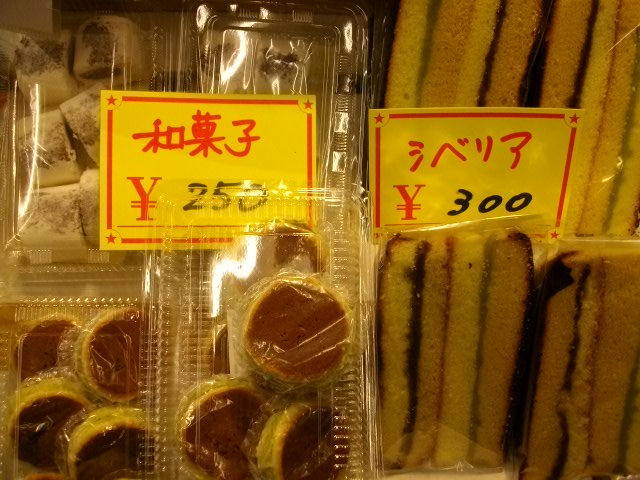
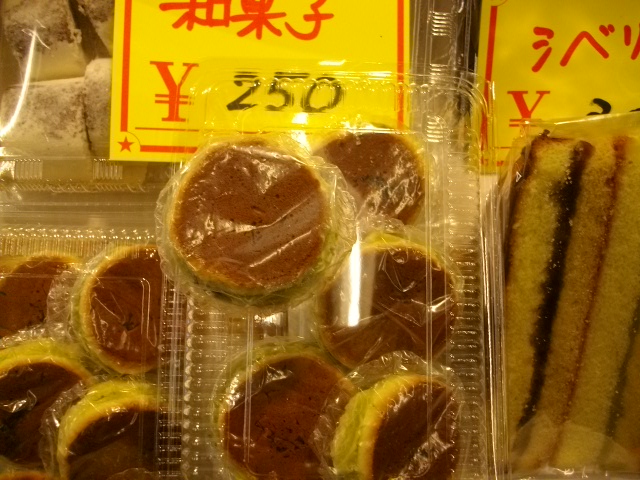
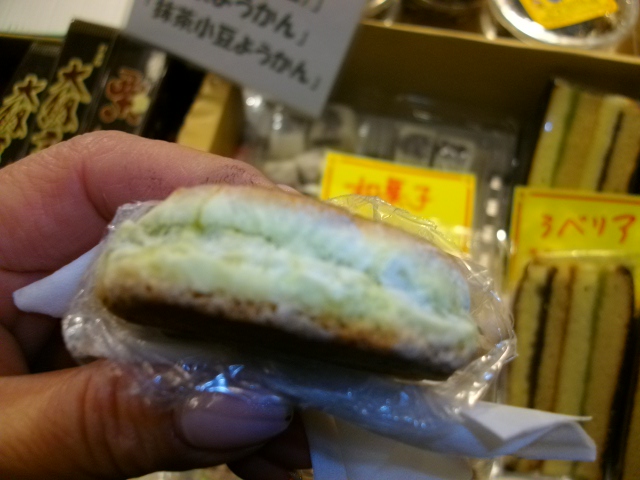
とんとんねこ
3.00
This store is located in the Tsukiji outer market area, and I decided to stop by after reading a review by the reviewer Nanagoro. They mentioned that you can get a pack of 5 straw-wrapped natto from Mito for 500 yen, or a pack of 2 cedarwood-wrapped natto for 120 yen, which are only available at this store and a shop inside Haneda Airport in Tokyo. While you can easily find natto in supermarkets for less than 100 yen, trying out these unique natto options can be a nice change. I had previously purchased the straw-wrapped natto when I visited Mito, so this time I bought the cedarwood-wrapped natto for 120 yen. Although I didn't notice much of a difference in taste, I think this store is recommended for those who are particular about their natto or for people who purchase seafood and vegetables at Tsukiji and want to pick up something unique on the side. It seems like a store where people who come to Tsukiji for groceries might also buy something from the store front.
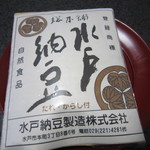
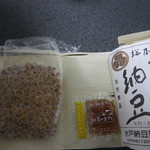
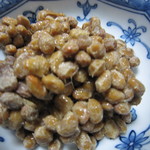
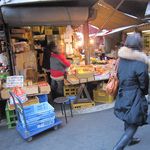
食遊人かずきち
2.50
It seems to be a new specialty dish that is popular in Tsukiji, but... If you walk from Ginza and continue straight at the Honganji intersection, turn right at the third street on the right, and then it's on the right side of the alley. The round one is completely steamed sea urchin with a chewy texture mixed with a small crunchy ingredient. The large one with a hole at the top had a slightly warm temperature and a nice sea urchin aroma. The bamboo shoot kneaded into the skin seems to eliminate any unpleasant smell. To be honest, it tasted exactly as it looked... No surprises, no excitement... Recommendation level is low, but since you're there, why not give it a try? (laughs) This is just my personal opinion, so please take it with a grain of salt.
peppai
3.00
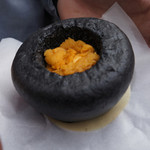

yumail
3.50
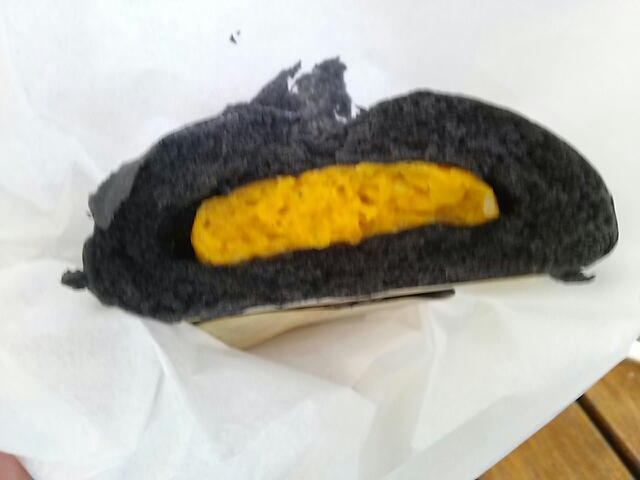
Email Login